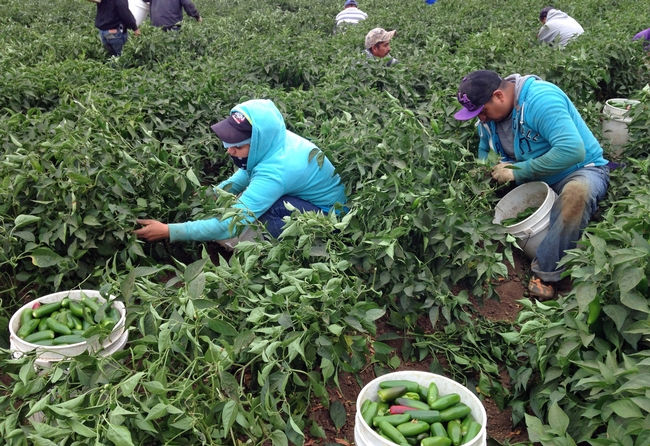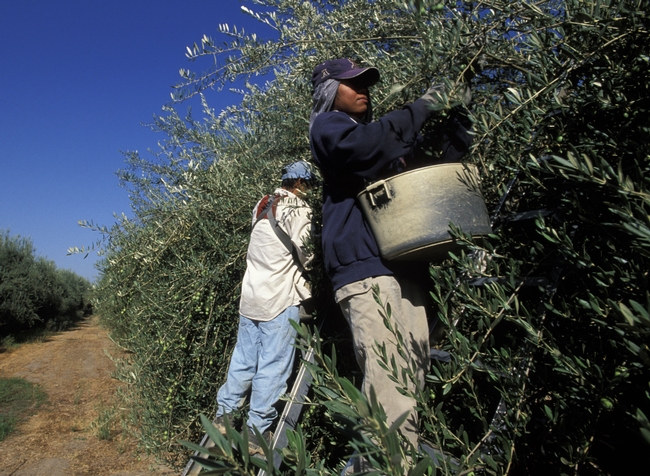Posts Tagged: farmworkers
Farmworkers at risk for obesity, high blood pressure, say UC researchers
Better access to health care and safety net programs would help
Farmworkers are a crucial link in our food supply chain, a fact that came sharply into focus during the early days of the COVID-19 pandemic. To keep these essential workers healthy, there is a need for more data on farmworkers' health. A new study published by University of California scientists looks beyond work-related health concerns such as heat and pesticide exposure to the general health of the people who help plant, nurture and harvest food in California.
“The study findings confirm the high chronic-disease burden in a workforce that is considered essential but lacks adequate access to health care and safety net programs,” said Susana Matias, lead author and UC Cooperative Extension specialist in the UC Berkeley Department of Nutritional Sciences and Toxicology. “This is a concern because California needs a healthy farmworker workforce. These workers are key to putting food on our tables and should be protected and supported as any other California worker.”
After reading the study, an advocate for women farmworkers said she sees opportunities to enhance farmworkers' health by improving their working conditions by enacting policy governing work permits; childcare; pest management; unemployment benefits; access to healthy and affordable food; and safe, affordable housing.
To see a broader perspective of farmworker health, Matias analyzed data from three studies by Marc Schenker, UC Davis physician and professor emeritus. Schenker's studies examined farmworkers' general health, occupational injuries and important causes of illness and disease. Causes or so-called “social determinants” of disease include low income, food insecurity, undocumented immigration status, and poor housing conditions.
“Those social determinants are particularly negative and impact disease outcomes in the farmworker population,” Schenker said. “Too often farmworkers don't have the benefits of other working populations, including adequate health care. It is hoped that recognition of this situation can lead to addressing these deficiencies and an improvement in farmworker health.”
Irene de Barraicua, director of operations and communications for Lideres Campesinas, said the study relates to much of the work her organization does advocating for women farmworkers.
“The article and studies emphasize findings that call for higher salaries, better working conditions, more worker rights and access to healthcare,” de Barraicua said. “From these findings, we can also gather that the health of farmworkers is impacted by various stress factors related to poverty, excruciating and unsafe work conditions, and lack of or costly childcare to name a few.”
Matias found that female farmworkers were at higher risk of obesity and larger waist circumference, while male farmworkers were at higher risk of high blood pressure and high total cholesterol.
“These differences in chronic health risks between farmworker men and women suggests that clinical and public health responses might need to be sex-specific,” said Matias, who is also co-associate faculty director at the Berkeley Food Institute.
The studies were conducted with farmworkers in Mendota, Oxnard and Watsonville. Matias would like to expand the scope to assess the health of farmworkers statewide.
“Our study is not representative of other regions of the state,” Matias said. “A representative survey is urgently needed in California to better identify and quantify the health problems in this population, and to provide the services needed by these essential workers.”
“The article ‘The Chronic Disease Burden Among Latino Farmworkers in California' clearly brings to the forefront very important sociodemographic and socioeconomic ‘gaps' unique to farmworkers, an essential segment of our population and workforce,” said de Barraicua of Lideres Campesinas.
“We need to enact policy that facilitates access to health care including mental health services; easily accessible, free rural and mobile clinics; telehealth services, essentially unrestricted healthcare coverage for all,” de Barraicua said, adding that trusted community health workers who know the farmworkers' culture and speak their language are needed.
She also noted the growing population of indigenous Mexican farmworkers and face greater challenges related to language access, limited education and immigration status.
The article, co-authored by Matias, Schenker, UC Berkeley postdoctoral researcher Caitlin French and student Alexander Gomez-Lara, is published in Frontiers in Public Health.
UCCE nutrition educators teach farmworker families about healthy eating
UC ANR partners with state and local organizations to improve urban communities. This story is one in a series about the impact of these partnerships.
The Farmworker Institute of Education and Leadership Development (FIELD), founded by Cesar Chavez in 1978, is dedicated to strengthening communities and the lives of farmworkers and immigrants in the San Joaquin and Sacramento valleys.
In Kern County, they are partnering with UC Cooperative Extension's CalFresh Healthy Living, UC program to ensure families have the knowledge and skills they need to buy and prepare food that will help prevent chronic diseases, such as diabetes and heart disease, and prevent obesity.
Each year, UCCE nutrition education supervisor Beatriz Rojas and UCCE nutrition education specialist Bea Ramirez present students in the program with eight free lessons on nutrition, physical activity and healthy living. Beginning in March 2020, due to the COVID-19 shelter-in-place orders, participants attended classes online, and the Kern County CalFresh Healthy Living, UC staff adapted their classes to an online platform.
FIELD requested nutrition classes for their 32 adult students during the summer session.
“We provided the students with lesson packets and followed up with one-on-one calls to review each lesson,” Rojas said. “The participants received vital information on how to keep themselves and their families fit and healthy, save money at the grocery store, make healthy food choices and prepare tasty meals.”
In one of the phone calls, a participant mentioned that she started to incorporate 30 to 40 minutes of stationary bike riding in her daily routine and started her family on this activity as well.
“Ever since I started the nutrition class, it has taught me how to read the nutrition facts label when I go to the store, also how to choose the right oil, meat and dairy,” the student said. “My family and I do a lot more physical activity at home and we eat healthier.”
The CalFresh Healthy Living, UC program and other UC ANR statewide programs rely on donor contributions. To learn more about CalFresh Healthy Living, UC and how to support programs in your area, visit the UC Youth, Families and Communities program website.
Trump presidency and potential impact on food prices
President-elect Donald Trump promised to crackdown on illegal immigration during his campaign. Caitlin Dewey reported in the Washington Post that such a move would result in increased fruit and vegetable prices for Americans.
The Post sought information from the UC Agricultural Issues Center (AIC), a statewide program that is part of UC Agriculture and Natural Resources. UC Cooperative Extension was credited as a source for a chart that accompanied the article that noted the crops most vulnerable to labor-cost change. Asparagus is listed as having the highest proportion of the farms' operating costs dedicated to labor: 82 percent.
"The plants must be hand cut multiple times per day during their two-month harvest season," the story said. Other crops that have high labor costs are wine grapes, oranges, sweet cherries, and all types of fruit. The article said berries, peppers, onions, watermelons and apples are also typically picked by hand.
A Texas A&M agricultural economist, Luis Ribera, told the reporter he believes U.S. farmers may not be able to produce some fruit and vegetables as a result of Trump's planned deportation of undocumented immigrants.
"We had a farm labor shortage even without Trump. Whatever he does will just compound the problem," Ribera said.
The director of the AIC, agricultural economist Daniel Sumner, doesn't express dire concern about the potential impact of the Trump administration on food prices and agriculture policy.
"I do not see big changes in immigration policy relevant for ag. Except perhaps a guest worker program, which would be positive," Sumner said. "I do not see big deportation of farmworkers coming."
California has a stable farm workforce
There are twice as many farmworkers as there are farm jobs in California, according to an analysis published online today (Aug. 23, 2016) in California Agriculture journal.
Led by Philip Martin, professor emeritus in the Department of Agricultural and Resource Economics at UC Davis, scientists analyzed all Social Security numbers reported by farm employers in 2014. The total number of farmworkers employed in California in 2014 was 829,300. The number of full-time equivalent jobs was 410,900.
“We have lots of people who do farm work in California,” Martin said. “If we could use more of them year round, we would not have to always be looking for immigrants.”
Interest in farmworkers and farm employment is growing in California and in the nation. Comments about illegal immigration by presidential candidates and a new law under consideration in California to require overtime pay for farmworkers have made farm employment part of a national conversation. California's labor-intensive fruit and vegetable production systems, the tightening of border controls and proposals to give some unauthorized workers a temporary legal status have also fueled interest.
“Many farm employers argue that there are farm labor shortages, while worker advocates counter that there is only a shortage of wages to attract and retain farmworkers,” Martin said. “Our objective was to provide a clearer picture of California's agricultural workforce by determining the actual number of wage and salary workers in agriculture.”
The research was based on information from the state's Employment Development Department, which collects data on farmworkers and wages paid when it collects unemployment insurance taxes from employers.
The results of the 2014 analysis are compared with previous analyses of farm employment going back to 1990. The data reflect a shift over the last 30 years away from direct-hire employment on crop farms and toward employment by farm labor contractors.
“Crop support services, like farm labor contractors, surpassed on-farm hires for the first time in 2007,” Martin said. “Since 2010, average employment reported by crop support establishments has been rising by 10,000 a year.”
In 2014, nonfarm crop support firms brought an average of 205,000 farmworkers to crop farms, while direct-hires on crop farms was 175,000.
“Our data show that California has a remarkably stable workforce,” Martin said. “We found that most farmworkers are attached to one farm employer, often a labor contractor who moves them from farm to farm.”
Average earnings for all workers who held at least one farm job during the year was over $19,000 in 2014, while average earnings of those who had their maximum earnings in agriculture was $16,500. Farmworkers who were employed by farm labor contractors had the lowest average earnings at $12,719.
In addition to Martin, the article was authored by Muhammad Akhtar, Brandon Hooker and Marc Stockton of the California Employment Development Department. California Agriculture journal is the peer-reviewed research journal of UC Agriculture and Natural Resources.
UC programs provide heat illness prevention training
Record-breaking heat led to 12 farmworker deaths in 2005, bringing the issue of heat-related illness to the forefront for California labor activists and legislators. New laws enacted since then call for employee and supervisor training, fresh water at work sights, access to adequate shade for rest and recovery periods and written documentation on site that provides information about the regulations.
As the hottest August on record comes to a close, the next essential task has become educating California’s diverse population of outdoor workers and their employers about the heat illness prevention rules, according to an article on HealthyCal.org.
At the heart of the educational efforts are “Train the Trainer” workshops in which representatives from UC Berkeley’s Labor Occupational Health Program along with UCLA's Labor Occupational Safety and Health Program, and UC Davis’ Western Center for Agricultural Health and Safety train representatives from schools, advocacy organizations, cultural centers, churches and health centers who in turn reached out to thousands of outdoor workers in their respective communities, the article said.
Related to this story, UC Agriculture and Natural Resources has a Heat Illness Prevention page on its website with the following articles:
- Ten key points about heat stress
- UC gives tips for coping with heat stress
- Heat illness symptoms and first aid
- How heat affects the body
- Preventing heat-related illness among agricultural workers (pdf)
Visitors can also download bilingual (Spanish and English) heat illness prevention handouts from the website.

In 2011, of 753 heat enforcement inspections, 76 percent of employers were found to be compliant.





